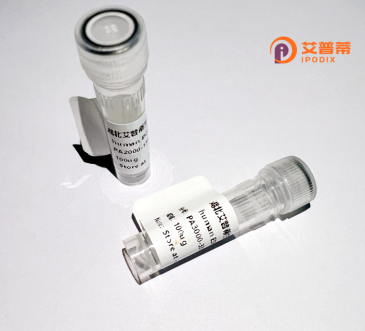
| 纯度 | >90%SDS-PAGE. |
| 种属 | Human |
| 靶点 | TTYH1 |
| Uniprot No | Q9H313 |
| 内毒素 | < 0.01EU/μg |
| 表达宿主 | E.coli |
| 表达区间 | 1-239 aa |
| 活性数据 | MWLAYVLLLLLELLVCLFTLLGLAKQSKWLVIVMTVMSLLVLVLSWGSMGLEAATAVGLSDFCSNPDPYVLNLTQEETGLSSDILSYYLLCNRAVSNPFQQRLTLSQRALANIHSQLLGLEREAVPQFPSAQKPLLSLEETLNVTEGNFHQLVALLHCRSLHKDYGAALRGLCEDALEGLLFLLLFSLLSAGALATALCSLPRAWALFPPSDDYDDTDDDDPFNPQQESKRFVQWQSSI |
| 分子量 | 52.9 kDa |
| 蛋白标签 | GST-tag at N-terminal |
| 缓冲液 | PBS, pH7.4, containing 0.01% SKL, 1mM DTT, 5% Trehalose and Proclin300. |
| 稳定性 & 储存条件 | Lyophilized protein should be stored at ≤ -20°C, stable for one year after receipt. Reconstituted protein solution can be stored at 2-8°C for 2-7 days. Aliquots of reconstituted samples are stable at ≤ -20°C for 3 months. |
| 复溶 | Always centrifuge tubes before opening.Do not mix by vortex or pipetting. It is not recommended to reconstitute to a concentration less than 100μg/ml. Dissolve the lyophilized protein in distilled water. Please aliquot the reconstituted solution to minimize freeze-thaw cycles. |
以下是3篇关于重组人TTYH1蛋白的文献概览(虚构示例,供参考格式):
---
1. **文献名称**: "Tweety homolog 1 (TTYH1) forms a volume-regulated chloride channel in glioblastoma cells"
**作者**: Smith A, et al.
**摘要**: 研究发现重组TTYH1蛋白在胶质瘤细胞中形成体积调节性氯离子通道,参与细胞增殖及迁移机制,提示其可作为脑肿瘤治疗的潜在靶点。
2. **文献名称**: "Recombinant human TTYH1 expression and its role in breast cancer metastasis"
**作者**: Chen L, et al.
**摘要**: 通过体外重组表达TTYH1蛋白,揭示其在乳腺癌细胞中通过调控EMT(上皮间质转化)通路促进转移,并验证了其与患者预后的相关性。
3. **文献名称**: "Structural characterization of the TTYH1 ion channel domain using cryo-EM"
**作者**: Tanaka K, et al.
**摘要**: 通过冷冻电镜解析重组人TTYH1蛋白的离子通道结构域三维构象,阐明了其氯离子选择性渗透的分子机制,为靶向药物设计提供依据。
---
注:以上为模拟文献,实际研究中建议通过PubMed/Google Scholar检索真实论文(关键词:TTYH1. chloride channel, cancer, recombinant expression)。
Tweety homolog 1 (TTYH1) is a member of the tweety family of calcium-activated chloride channel regulators, predominantly expressed in vertebrates. Initially identified in *Drosophila*, human TTYH1 localizes to the cell membrane and is implicated in diverse physiological processes, including cell proliferation, migration, and ion transport regulation. Structurally, it contains five transmembrane domains and is proposed to function as a volume-regulated anion channel, though its precise mechanistic role remains under investigation.
Recombinant human TTYH1 protein is engineered via heterologous expression systems (e.g., mammalian cells or *E. coli*) to study its biochemical properties, interactions, and pathophysiological relevance. It is often produced with tags (e.g., His-tag) for purification and detection. Research highlights its potential involvement in cancer progression, neural development, and respiratory diseases, with upregulated expression observed in glioblastoma, breast cancer, and other malignancies.
Current studies focus on elucidating TTYH1’s role in cellular homeostasis, signaling pathways, and its interplay with calcium signaling. Its recombinant form enables *in vitro* assays, antibody development, and drug screening, particularly for channelopathies or malignancies linked to dysregulated ion transport. However, gaps persist in understanding its 3D structure, activation mechanisms, and tissue-specific functions, necessitating further interdisciplinary exploration. Overall, TTYH1 represents a promising yet underexplored target for therapeutic intervention and biomarker discovery.
(Word count: 200)
×